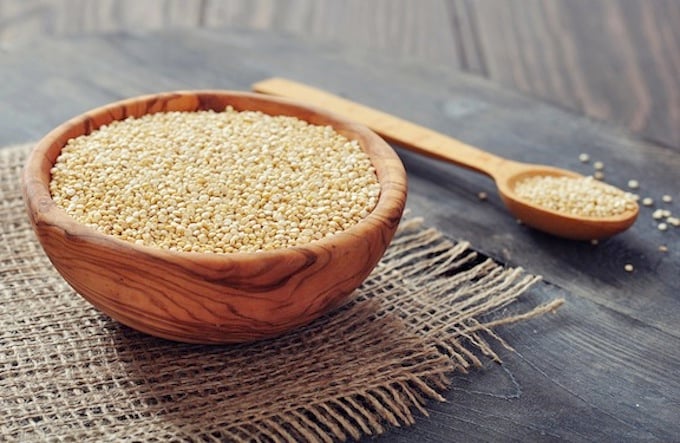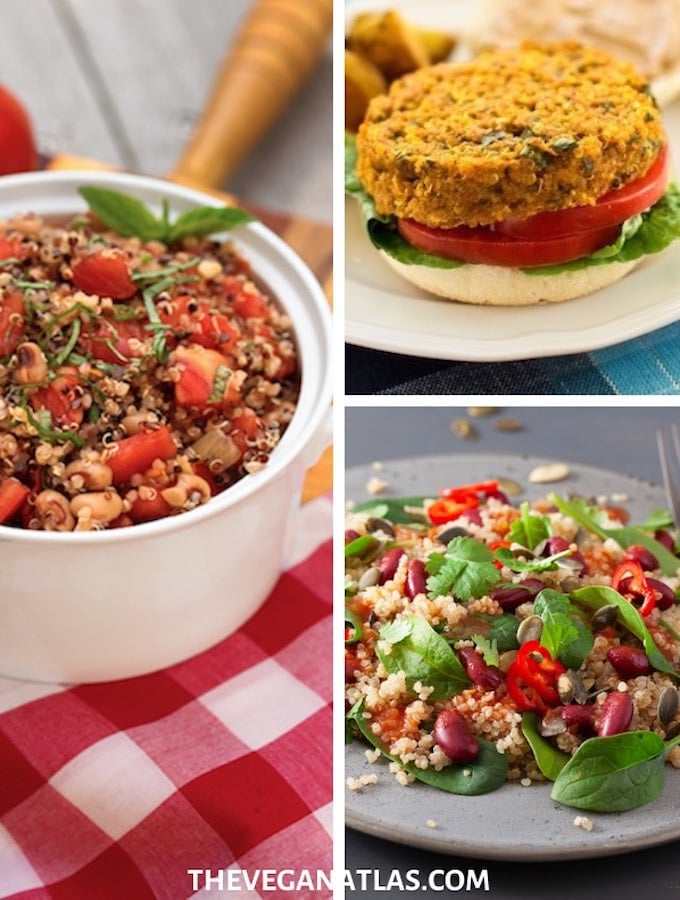Here’s a quick guide to quinoa, with tips for buying, using, storing and cooking with this versatile supergrain. High in protein, quick to cook, and with a distinct flavor, quinoa has earned its place as a staple culinary grain.

With its mild, distinctly nutty flavor and light, fluffy texture and quick cooking time (about 15 minutes), quinoa is a boon to busy cooks, and it’s gluten-free, too.
A bit of history; is quinoa an ancient grain?
Pronounced KEEN-wa, it’s a historic companion to the grain amaranth, another esteemed ancient staple crop that gradually fell into disuse after the sixteenth-century Spanish conquests of the Andean and Central American cultures. The nutritional profiles of quinoa and amaranth are quite similar.
Traditionally grown in the South American Andes, especially Bolivia and Peru, according to GoGo Quinoa, “There is archaeological evidence that quinoa was grown as early as 5000 years ago in Peru, Bolivia, and northern Chile.
For many centuries, quinoa was a very important crop for Andean cultures in those areas as well as in present day Colombia and Ecuador.”
You can read more about its history in The Story Behind the Popular Superfood, Quinoa.
The quinoa plant thrives in the thin air, low rainfall, and extreme temperatures of high altitudes. It grows well even in very poor soil. All these factors explain why quinoa has long been a valued crop in the mountainous regions of South America, where few other crops can survive.
Quinoa started appearing in the North America natural foods market in the 1970s. More recently, it has been cultivated in the Rocky Mountains of the U.S. and Canada.

Quinoa in all its forms
Quinoa grains (technically seeds) are irregularly roundish. The most common variety is a sandy, or tan color. Red and black varieties are available as well. Red quinoa tends to be a bit firmer, so it’s great in salads. Black quinoa has a slightly earthier flavor. The three colors are sometimes combined into one mix, which has a lot of eye appeal.
It’s also available as quick-cooking quinoa flakes, which can be used as a hot cereal much like oatmeal. It’s also milled into a versatile, gluten-free flour that’s sold on its own, and is sometimes used in other products like pasta.

Buying and storage
Look for quinoa sold in boxes or plastic jars in the natural foods store, or the natural foods section of supermarkets. Ditto for natural foods stores. Rice Select®, Ancient Harvest®, and Bob’s Red Mill® are popular brands.
As with other grains, quinoa is more economical to buy quinoa in bulk. Buy quinoa from a source that has good turnover. You can find good deals for quinoa online as well.
Though it doesn’t tend to go rancid like nuts, for example, it is best when fresh. It will keep well in a cool, dry pantry for several months (transfer to a tightly lidded glass jar). If your kitchen is warm during summer months, it wouldn’t hurt to store it in the refrigerator.

How to Cook Quinoa
The basic recipe for cooked quinoa calls for 2 cups water (for variety, you might like to occasionally use a light vegetable stock or toss a bouillon cube into the mix) to 1 cup grain. The deeply colored varieties like red and black (or the mixtures) seem to need a little more water, so make that 2 1/2 cups to 1 part grain.
Rinse the quinoa in a fine sieve. Combine in a sauce pan with the correct amount of water. Bring the water to a slow boil. Lower the heat and simmer gently, covered, until the water is absorbed, about 15 minutes.
Toasting the grain: Like other grains, the nutty flavor and aroma of quinoa is enhanced by toasting it lightly in the saucepan for about 5 minutes over medium heat before cooking. Stir often.

Make sure to explore Easy Quinoa Recipes
Nutrition info
You get a lot of nutritional value for the buck; and since raw quinoa expands greatly when cooked means that a little goes a long way. At 16 percent protein, it surpasses other grains not only in quantity but also in quality of protein, with substantial amounts of all the essential amino acids.
A cup of cooked quinoa contains about 220 calories, 8 grams of complete protein, 5 grams of fiber, and 39 grams of carbs.
It’s also rich in minerals, particularly calcium, phosphorus, and iron. Quinoa also provides a wide range of the B-complex vitamins as well as vitamin E. Considered a super grain for its excellent nutritional profile, quinoa has a lot going for it.
A common question asked — is quinoa better than brown rice? You can learn more here:
 Quinoa is a fantastic component of Buddha bowls
Quinoa is a fantastic component of Buddha bowls
Some simple ways to use quinoa
Bowl basic: Quinoa is a perfect grain component for colorful Buddha bowls, warm or cold. Here are some beautiful Buddha bowls to make without a recipe. You’ll see that quinoa is a component of some of them.
A simply seasoned sided dish: Quinoa is tasty simply seasoned with vegan butter, scallions, and black pepper.
Substitute for bulgur: Substitute quinoa in any recipe calling for bulgur wheat. For instance, quinoa makes a light and tasty tabbouli.
Substitute for couscous: Quinoa makes a more nutritious (and gluten-free) substitute for refined couscous. For instance, use it as a cushion for Moroccan-style stews that normally call for couscous.

A basic bed of grain: Use as a bed of grains for bean dishes, curries, stir-fried vegetables—in fact, anywhere you’d use rice.
A perfect pilaf grain: Use as a base for simple pilafs, of course — laced with nuts, dried fruits, vegetables, herbs, spices in your favorite combinations.
Hot vegetable stuffer: Seasoned quinoa makes an excellent stuffing for vegetables. One idea: Heat olive oil or vegan butter in a skillet and sauté chopped onions and minced garlic until golden. Add cooked quinoa, chopped fresh herbs, a pinch of ground cumin, and salt and pepper. Use to stuff pre-baked zucchini, winter squashes, bell peppers, or eggplant.
Cold vegetable stuffer: Use a quinoa salad like tabbouli to stuff raw bell pepper boats.

Taco filling: Cooked in tomato sauce and spiced, quinoa makes an excellent taco filling. Here’s a good recipe for “Taco Meat.”
Soup grain: Add a small quantity of cooked quinoa to all kinds of vegetable soups — or cook it in longer-simmering soups.
Casserole grain: Quinoa is great in casseroles, too. Swap it in for rice and other grains. A simple idea — Layer an oiled 1 1/2-quart casserole dish as follows: 1 1/2 cups cooked quinoa, 2 cups steamed chopped broccoli (both seasoned with salt and pepper), 2 scallions, thinly sliced, and 3/4 cup vegan cheddar shreds. Repeat the layers. Bake at 350ºF until the top is golden and crisp, about 30 to 40 minutes.
A hot breakfast bowl: Serve cooked quinoa as you would any hot cereal or grain, embellished with fresh and dried fruit, nuts, and sweetener. Here’s a simple quinoa breakfast bowl to try.
Wrap it up: Add a scoop of quinoa to vegetable-filled wraps for extra protein and texture.
More ancient grain guides
And see more Good Food Guides on this site.

We kosher vegans had to struggle to get Rabbis to approve its use during Passover when grains (and even grain like produce for Ashkenazi Jews) are prohibited for the entire 8 (7 in Israel). Fortunately quinoa is now a vegan staple for those of us who follow the Jewish Law, albeit with cautions and precautions. I’ve learned a few tricks.
First, you do have to rinse. Even if the quinoa is sold as already rinsed, you don’t want to take a chance the very better taste still remaining. (Stories have it that the Incas used the water from rinsing to rinse the oils out of their hair. The residue from rinsing is very powerful. I even lift off the few white bubbles that rise to the surface when the quinoa water begins to boil.
Second, invest in a special double layered or fine mesh strainer. Watching this very expensive item float down your drain is a frustrating experience. A proper strainer will save you money and agitation.
Third, although almost all recipes instruct you to use 2 cups water to 1 cup quinoa, I have found that if you have a good solid pot (mine is anodized aluminum) using a little less actually works better. So I use 1 and 3/4 cup water to 1 cup quinoa. Bring to a boil and them immediately cover and lower the heat to a very low or simmer temperature. The quinoa using this formula cooks a bit faster than specified and has a better over all bloom. Passover is almost upon us and we’re getting ready to stock up. Great for breakfast with dried fruit and cinnamon, for lunch as a version of tabouli, or dinner with mushrooms and asparagus. (Ideally not on the same day!)
Thank you so much for all these valuable additions to this Guide! And Happy Passover, Ruchama.